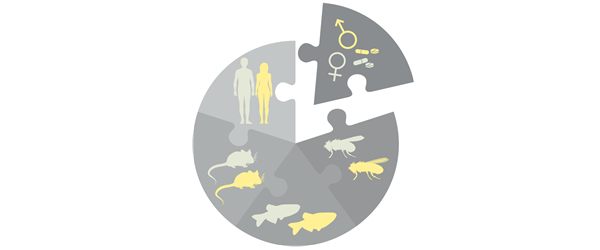Issues
-
Cover image
Cover Image

Cover: A section through the trigeminal ganglion of a 1-week-old mouse pup carrying a heterozygous deletion of 28 genes on mouse Chromosome 16 that is orthologous to the deletion associated with the human developmental disorder 22q11.2 deletion/DiGeorge syndrome. The deletion alters interactions between neural crest-derived (green) and placode-derived cells early in embryogenesis, leading to changes in the proportions and molecular identities of nociceptive neurons, a subset of which is labelled for the neurotrophin receptor TrkA (red). See article by Karpinski et al. (dmm047357). Cover image is licensed under a Creative Commons Attribution 4.0 International license.
- PDF Icon PDF LinkTable of contents
- PDF Icon PDF LinkIssue info
Special Issue: The RAS Pathway
EDITORS' CHOICE
EDITORIAL
Understanding and drugging RAS: 40 years to break the tip of the iceberg
Summary: This Editorial introduces DMM’s new Special Issue on the RAS pathway. The Guest Editors reflect on the impact of the featured articles on the landscape of the RAS field.
A MODEL FOR LIFE
PERSPECTIVE
Defining RASopathy
Summary: RASopathy is a term used to unify a phenotypically similar group of medical genetic syndromes, yet its definition is challenging and should consider the perspectives of clinicians, scientists and the patients.
SPECIAL ARTICLE
RAS and beyond: the many faces of the neurofibromatosis type 1 protein
Summary: Neurofibromatosis type 1 has provided unprecedented opportunities to define the importance of RAS regulation in health and disease. Emerging research has also unveiled the role of non-canonical RAS and RAS-independent signaling in this RASopathy.
REVIEWS
RAS pathway regulation in melanoma
Summary: This Review describes the molecular regulation of the RAS pathway, presents the clinical consequences of its pathological activation in human cancer, and highlights recent advances towards its therapeutic inhibition, using melanoma as an example.
The RASopathies: from pathogenetics to therapeutics
Summary: RASopathies are developmental disorders caused by germline pathogenic variants in RAS/MAPK pathway genes. Here, we review the preclinical studies that provide the basis for future interventional clinical trials for RASopathy patients.
RAS-mediated tumor stress adaptation and the targeting opportunities it presents
Summary: The acquisition of oncogenic RAS simultaneously causes cellular stress and activates stress-adaptive pathways. Many of these are implicated in resistance mechanisms to RAS-targeting therapies, posing as therapeutic targets to block stress-activated mechanisms of resistance.
RESEARCH ARTICLES
Analysis of the H-Ras mobility pattern in vivo shows cellular heterogeneity inside epidermal tissue
Summary: Single-molecule microscopy analysis of factors altering the in vivo dynamics of H-Ras proteins in epidermal cells in living zebrafish embryos revealed that cell architecture and protein activation state determine protein mobility.
Ras signaling and RREB1 are required for the dissociation of medial edge epithelial cells in murine palatogenesis
Summary: RREB1, a known transcriptional factor that acts downstream of Ras signaling, is expressed in the medial edge epithelium (MEE) region and required for the dissociation of MEE during palatal fusion.
Statins mediate anti- and pro-tumourigenic functions by remodelling the tumour microenvironment
Summary: Characterisation of mouse lung adenoma/adenocarcinoma models treated with atorvastatin revealed that statins remodel the tumour microenvironment in lung adenocarcinoma development to create pro- and anti-tumourigenic effects dependent on disease stage.
MEK-inhibitor-mediated rescue of skeletal myopathy caused by activating Hras mutation in a Costello syndrome mouse model
Summary: A Costello syndrome (CS) mouse model carrying a heterozygous Hras p.G12V mutation was utilized to investigate Ras pathway dysregulation, revealing that increased MAPK signaling is the main cause of the muscle phenotype in CS.
Pharmacological or genetic inhibition of hypoxia signaling attenuates oncogenic RAS-induced cancer phenotypes
Summary: Hypoxia pathway inhibition, either genetically or pharmacologically, rescues RAS-induced oncogenesis in a Drosophila acute myeloid leukemia model, mouse xenograft model and human leukemia cells.
Tissue architecture delineates field cancerization in BRAFV600E-induced tumor development
Summary: This study investigates how a BRAF-mutant lineage becomes cancerized by escaping cell competition from non-mutant cells in a mouse model of sporadic thyroid cancer.
Selective disruption of trigeminal sensory neurogenesis and differentiation in a mouse model of 22q11.2 deletion syndrome
Summary: Altered proportions, distribution, timing and modes of division for trigeminal ganglion progenitors prefigure divergent trigeminal sensory neuron differentiation and oropharyngeal dysfunction in the LgDel mouse model of 22q11.2 deletion syndrome.
RESOURCE ARTICLE
K-Ras and p53 mouse model with molecular characteristics of human rhabdomyosarcoma and translational applications
Editors' choice: We developed a new conditional genetically engineered mouse model of rhabdomyosarcoma (RMS) with homologous molecular signature to human RMS that provides valuable pre-clinical models for evaluating novel therapies.
FIRST PERSON
Sex matters in preclinical research

DMM calls for improved inclusion, analysis and reporting of sex as a biological variable in preclinical animal modelling research. Read the full Editorial by Monica J. Justice.
Subject collection: Building advocacy into research

DMM’s new series - Building advocacy into research - features interviews, ‘The Patient’s Voice’, with patients and advocates for a range of disease types, with the aim of supporting the highest quality research for the benefit of all patients affected by disease.
Travelling Fellowships for early-career researchers

DMM and its sister journals offer Travelling Fellowships of up to £3,000 to graduate students and post-doctoral researchers wishing to make collaborative visits to other laboratories. Find out more about our Travelling Fellowships and read stories from previous grant recipients.
Read & Publish Open Access publishing: what authors say

We have had great feedback from authors who have benefitted from our Read & Publish agreement with their institution and have been able to publish Open Access with us without paying an APC. Read what they had to say.
The Forest of Biologists
Our Publisher Claire Moulton recently visited the two Woodland Trust UK sites where we are planting new native trees for published Research and Review papers and protecting ancient woodland on behalf of our peer reviewers.



